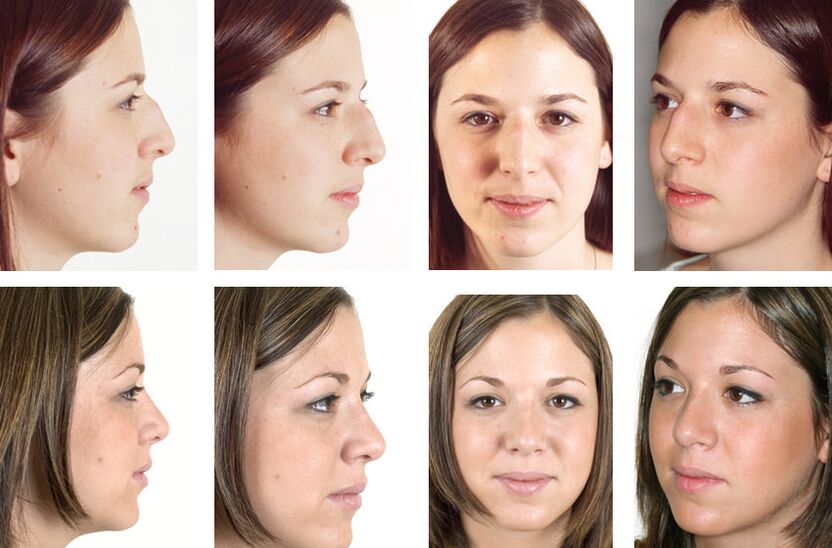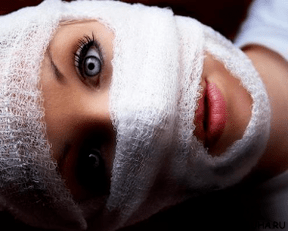Rhinoplasty is a special surgical operation, which is performed to correct congenital or obtained nasal defects, as well as a total increase in lost nasal parts.
The operation of rhinoplasty lies in the fact that the surgeon changes the nasal parameters by invading the nasal bone frame.
The main task of such surgery is to return the exact nasal shape to a person who was violated even before birth, due to illness or through acquired nasal damage.

Types of rhinoplasty
Today, the world uses such types of nasal rhinoplasty:
Septoplasty
Sepoplasty is a surgical intervention that sets the task of eliminating defects in the nasal septum itself - the displacement of the cartilage and bone, which interfere with normal functions and aesthetic type of nasal.
Indications for septoplasty for humans:
Contraindications to septoplasty:
Rhinoplasty
Closed rhinoplasty as an operation is more easily tolerated by a patient than open rhinoplasty. This procedure is performed by the endonasal access to the nose, that is, the incisions are made directly inside the nose.
This surgery has a number of advantages for the patient, but is extremely unsuitable for the surgeon, as it is easier for any surgeon to perform operations in an accessible operating area. Therefore, in closed rhinoplasty there are much more chances of getting a medical error, as a result of which complications or other problems in the patient can occur.
Advantages of closed rhinoplasty:

Indications for closed rhinoplasty:
Contraindications to this type of operation:
Since closed rhinoplasty is a very complicated surgery, after its behavior, the patient may have the following complications:
Rhinoplasty
Open rhinoplasty, unlike a closed one, is performed with a small cut, with a diameter of 4 - 5 mm. Thanks to such a visible part, the nasal skin can rise completely and then the surgeon will be much more convenient to work with an open nasal skeleton because it will see in front of it the entire outer structure of this organ, unlike the closed rhinoplasty. This greatly reduces the chances of a surgical error.
Moreover, open rhinoplasty is recommended for primary operation, as it can more accurately eliminate all existing nasal defects, unlike closed rhinoplasty, which may not always guarantee the same result.
Rhinoplasty in secondary behavior
Secondary rhinoplasty is performed if the start was unsuccessful and it is necessary to correct the complications. Can be performed both open and closed.
Rhinoplasty
Rinoplasty without surgery is performed only in 4-7 % of patients who can do without surgery. With its help, only small nasal defects can be corrected. More serious problems in the structure and appearance of the nose require only a thorough operation of rhinoplasty.
Rhinoplasty when using filler
This procedure is performed if the patient wants to eliminate only minor nasal defects. For example, these can be different small, flawed disadvantages, enlargement of the nose, inaccuracy of its symmetry, etc. In these cases, doctors use special fillers that enter the nasal tissue and they correct the problem.
The advantages of this method are that nasal restoration as it is much easier, and the procedure itself is not as painful as the usual surgical intervention.
The disadvantages of rhinoplasty using fillers are a change in the structure of the nasal tissue and the possible "migration" on the nasal surface of the administered medicine.
Rhinoplastics using special auxiliary medicines
To perform such a procedure, surgeons use special medicines based on hormones that enter damaged nasal areas.
The advantage of such a rhinoplasty is that the patient is not subject to surgical intervention. But a major disadvantage of such a rhinoplasty is that with improper calculation of the drug dose and its insertion into the wrong area in the nose, the patient may have different complications and deterioration of defects.

Rhinoplasty using strands
This procedure is performed using the strands by which doctors pull the nose and nose wings. These strands lie through special punctures on the nose and, as it were, pull the nose.
Rhinoplasty using yarn is not used very often by surgeons, as there are a number of disadvantages:
The pros and the evils of rhinoplasty
Rhinoplasty pluses:
Rhinoplasty against:
Indications and Contraindications
If a person has congenital nasal defects, but he can perform rhinoplasty with the onset of adulthood. In general, the age of 18 to 40 is considered the most appropriate age for this procedure, when the body is already formed and a person makes a balanced decision.
Indications for rhinoplasty:
Contraindications to rhinoplasty:
Preparation for rhinoplasty
Since rhinoplasty is a complete surgery, for some time before it, the patient should do the following:

Performing operations - stages
Rinoplasty is performed in the following stages:
Depending on the level of complexity and the course of the procedure, the rhinoplasty operation can last from 50 minutes to 2 hours. It should also be mentioned that the nose after surgery may undergo independent changes in the form of improvements or deterioration.
All this will depend on the patient, his compliance with medical and direct recommendations, the results of the operation itself, which will only be visible after 6-8 months.
Rehabilitation
After rhinoplasty, in the nose and around its region, such as vaccine, swelling and hematomas are formed, which usually go within two weeks. After surgery, a special fixed bandage is applied to the patient's nose, which should be worn within ten days. Tampons will also get into the nose, which will prevent bleeding so that for some time the patient is not able to breathe from the nose.
The result of the operation can be estimated in six months, and the end result is in one year. Delay of wounds after surgery depends on each person individually and the state of his vibrancy. If complications are observed after surgery, then healing lines can increase significantly.
After rhinoplasty, it is desirable to visit his surgeon to perform nasal inspections after rhinoplasty.
Pre -and post -operative recommendations
Before surgery, the patient follows:
After surgery, the patient must comply with the following requirements:

Possible complications after surgery
After rhinoplasty or during the procedure itself, the following complications may occur:
results
The first results of the operation will be visible after 10-14 days. But the patient can only see the end result after 8-10 months, when all the edema and numerous bruises will be removed and the fabrics will be "placed" on the new nose.
It is often the case that relatives and friends do not notice significant changes in the occurrence of the patient after surgery. Since hematomas and swelling will kill the entire result. In this case, the patient does not need to run immediately in repeated rhinoplasty, but it should only be cut when the face comes in the usual form and then evaluate the end result.
It should also be shown that rhinoplasty does not give a genetic effect and will not be transmitted by the clan for children, as some patients may consider. This operation only improves a person's appearance.




















